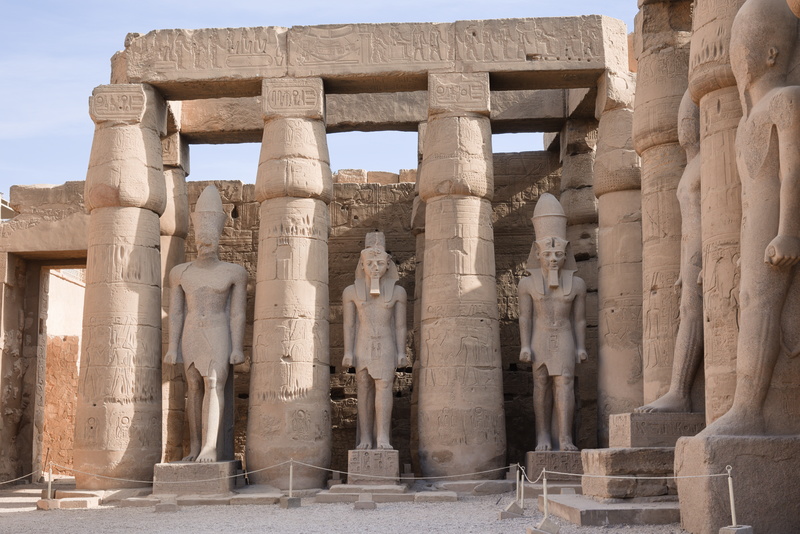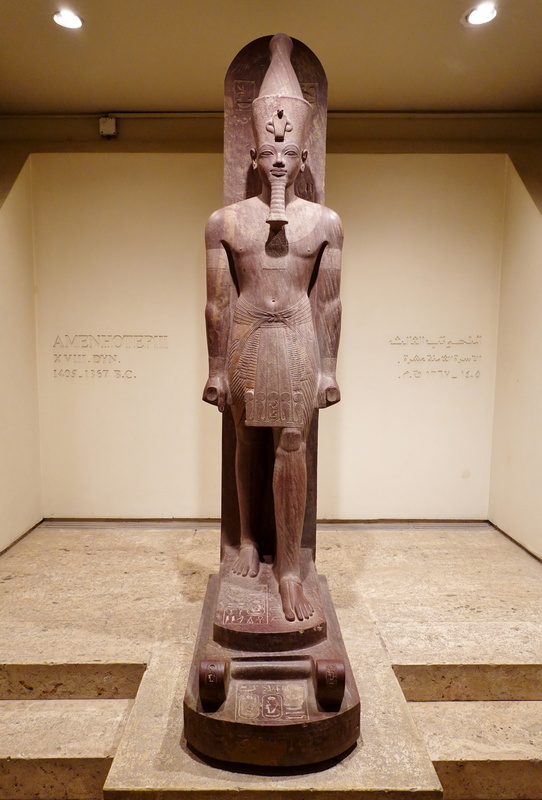How Doth the Little Crocodile...
⬅ previous ⬆intro next ➡Day 5 ~ January 24 ~ Luxor

Looking out from our hotel room window, we see a flotilla of hot air balloons drifting past. This particular one seems a bit low, and possibly gets closer to the roof of the next building than its passengers might wish, although it's hard to be certain from our angle.

After we've had breakfast and are getting ready to go, suddenly our phones ring with a WhatApp call. Rob is trapped! Rawya misses the call, but we update her by text.

A pot shop, or something, in what is basically the middle of nowhere as we drive this road.
Presumably this is the middle of somewhere we just don't know about.

Grain stores, again seemingly in the middle of nowhere. I think we need to re-evaluate "nowhere".

Here we are at the Dendera temple complex, at the entrance to the largest temple, dedicated to Hathor.

Look closely as we pass under the gate: this is the underside of a sacred Scarab beetle, and it's very unusual, perphaps unique in Egypt. Certainly at least one web site claims so.

These curious forms are the result of the stone being scraped to make a powder with supposed magical powers. Interesting commentary here.

The hypostyle hall.
We're told that the acoustics of the temple have been designed so that the voice of the hidden priestess can be clearly heard outside by the worshippers.

The ceiling has pictures illustrating the signs of the Zodiac: Taurus for Amanda here.

It's a bit of a squeeze to get into this chamber.

Ah, I wondered if we'd see this.
It represents an Egyptian creation myth, and is described as such by the surrounding hieroglyphs. However, the lunatic fringe of Ancient Astronaut types have decided that this is actually an electric light bulb. Power came from the free energy generators of the Pyramids, a technology that Tesla rediscovered but which was suppressed by the electricity industry because they wouldn't be able to profit from it. This sort of thing appears a lot in my Facebook feed.
Mind you, there are weirder notions. I'm not sure what this one is even claiming!

Rawya explains more about the carvings.

There's a lot of graffiti too.
A Belgian chap by the name of Roger O. De Keersmaecker became fascinated by the graffiti of Egypt and the Sudan, and made studying and recording it his life's work. Eventually he published sixteen volumes of which one is dedicated to Dendera. On his death in 2020, his materials were donated to the Griffith Archive at Oxford University, but you can see his Dendera volume here. I note that he doesn't have his own record of Mr/Ms Simpson's graffito, referring instead to Jochen Halllof's classic work, "Besucherinschriften in den Tempeln von Dendera", which you can read here. Given that he's dead, I regrettably can't send him my picture to add to his records.
So farewell Dendera, it's back to Luxor, and the Luxor temple complex itself.

The temple entrance.

Did you guess these statues were Rameses II? Award yourself top marks if so.

Quite a lot of this temple is damaged, but here are some columns and statues that have survived quite well.

You can see how huge the columns are.

The mosque of Abu Haggag is built within the temple on a site which had previously been converted to a Christian basilica in Roman times.

Back outside, looking in the opposite direction from the entrance, we have the Avenue of Sphinxes which runs directly to the Karnak temple.

This is one of the best preserved sphinxes.
Note, incidentally, that its tail is curled up on its right hand side. Amanda has noticed that all sphinxes seem to have their tails on the right, never on the left; she asks Rawya if this is truly the case, and if so, why? Rawya has never heard this question before and is unaware of any study of it!
We seem to have discovered a new field of Egyptological research, and trust Amanda will be cited as co-author on any future papers.
She has also realised that the avenue is just over two and a half kilometres long so would be perfect for an out-and-back parkrun!

The boat is a modern reconstruction, of course.

The avenue was only formally opened to the public in its restored state in 2021, after more than seven decades of work, and a number of posters along it document the process.
This article here describing the grand opening tells us,
"The first trace of the Avenue of Sphinxes was found in 1949 when Egyptian archeologist Mohammed Zakaria Ghoneim discovered eight statues near the Luxor Temple. Further statues flanking the road were uncovered in subsequent decades, with excavation works interrupted for long intervals as Egypt fought several wars."
We'll be visiting the Luxor Museum early this evening, but now we have a bit of free time back at the hotel.

We take a stroll around the grounds and find some rather strange little sculpture groups like this.

Before dinner, the Luxor Museum, which is another of these rather frustrating "no photography" places. The pieces on display have been chosen for quality rather than quantity, so a visit doesn't take all that long but is well worth it.

Once again, "no" doesn't seem to mean "no" in the fullest sense, so I shall simply borrow somebody else's picture to give you an idea of what's inside.
Thanks to Olaf Tausch - CC BY 3.0, https://commons.wikimedia.org/w/index.php?curid=85728433
I don't know whether he got special permission or just snapped it while the guards were looking the other way, but it would be a pity to have nothing from the museum collection here.

Finally it's dinner and an early night: we are going to be at Karnak for sunrise tomorrow!
⬅ previous ⬆intro next ➡